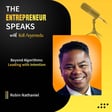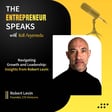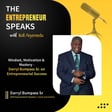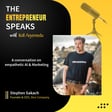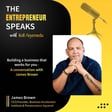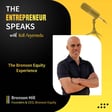Become a Creator today!Start creating today - Share your story with the world!
Start for free
00:00:00
00:00:01

Demystifying Customer Experience - A Conversation with a practitioner
" Your customer is your life-line to your business "
Adwoa Asare - Asamoah, Ahimaa the CX Story teller, Lead Consultant, CX Hatchery & Associates shares insights and strategies for creating a customer-centric culture , enhancing customer engagements and delivering exceptional customer service on the show.
Whether you are a small business owner or an employee , this episode is packed with actionable advice and real -world examples that you can apply to your own business.
Enjoy this episode and don't forget to like and subscribe .
Cheers !!
#theentrepreneurspeakspodcast #customerexperience #ahimaathecxstoryteller #cxhatcheryandassociates
Transcript
Introduction to Customer Experience as a Business Imperative
00:00:00
Speaker
So I'll say that customer experience is a new battleground. It's all about your customer. And you need to have the necessary omniscience to fight on this battleground. Otherwise, your business will die. Your customer is the lifeline to your business. So if you don't prepare yourself to take over, another business will take over.
00:00:30
Speaker
CX is the way to go. Businesses should set up and look at how they can focus on CX to make their customers happy. A happy customer impacts on a happy, makes a happy employee, and a happy employee also makes a happy customer. At the end of the day, the institution generates value.
00:00:55
Speaker
and the customer also creates
Podcast Introduction and Theme
00:00:58
Speaker
value. Welcome friends to The Entrepreneur Speaks. I'm your host Kofi Anumaidu. Each week I host an amazing entrepreneur on their journey, successes and challenges. It is my hope that we will learn from their experiences as we all work towards living a life of passion and purpose.
00:01:22
Speaker
Welcome to the Entrepreneur Speaks podcast, the show that helps businesses and entrepreneurs stay ahead of the curve by providing insights, tips and strategies for business growth. In today's episode, we'll be delving into the world of customer experience, exploring what it means to create a positive and memorable experience for your customers and why it's more important than ever in today's competitive marketplace.
Guest Introduction and Career Journey
00:01:52
Speaker
Our guest today is Adwoa Asaryasamwa, lead consultant of CX Hatchery and Associates Limited. She's a customer experience management practitioner with 19 years work experience in the financial industry. She'll be sharing insights and strategies for creating a customer-centric culture, enhancing customer engagement, and delivering exceptional customer service.
00:02:19
Speaker
whether you're a small business owner or an employee at a large organization, this episode is packed with actionable advice and real examples that you can apply to your own business. So sit back, relax, and get ready to learn how to take your customer experience to the next level. Welcome to my show, Adra. Thank you, Kofi. Happy to be here.
00:02:42
Speaker
Sure, sure, sure, sure. It's always good to sit down with people like you. Can you tell us a bit about your background and how you got started in the field of customer experience? Okay. Thank you very much. And as you rightly introduced me, I have 19 years experience in the financial industry. I happen to go into banking and specifically customer service by chance.
00:03:12
Speaker
And I spent two years in Prudential Bank and approximately 17 years in Kalbank. During my time as head of client services in Kalbank, I realized that I was doing more of firefighting than strategic service delivery because it dawned on me that a lot of the service related issues were repetitive.
00:03:40
Speaker
So I knew there was a gap some way, but I couldn't tell, or I couldn't pinpoint exactly what was missing. It so happened that I had the opportunity to attend a customer experience sandwich program in the University of Victoria in South Africa. And that was where I had my AHA moment. That was when I realized that I had found where the missing link was. So I came back home and implemented
00:04:10
Speaker
the knowledge that I gained from the sandwich program. And indeed, it really brought gains into my career and my output as a service practitioner. So in short, that is how I got myself into customer experience.
00:04:29
Speaker
Okay, that's a very wonderful experience, yes. So now let's talk about it. We hear this word over and over, customer experience, CX. How do you define customer experience and why is it important for businesses to focus on
Defining Customer Experience
00:04:48
Speaker
it? Simply put, I'll say CX is the perception of the customer of a brand.
00:04:56
Speaker
on the sum of all experiences the customer has across all touchpoints. Or see it as the perception the customer has of a company on the sum of all the experiences the customer has across the touchpoints within that journey. So as the customer is consuming a product within an institution or of an institution, the experiences that the customer has, shapes the customer's perception of what the brand is or who the brand is.
00:05:27
Speaker
Managing customers' perception of a brand is fundamental to achieving positive CX. And this is where the complexities of CX reside. It is important that you know your customer, or you know your customers, to enable you pre-empt their needs, to curate the element within the customer's journey that will create a positive perception. Perception is everything when it comes to CX.
00:05:56
Speaker
Because if the perception does not become the customer's reality, if there's incongruence between what the customer think a brand is and what the brand is actually providing or whether the reality of the brand, it affects the customer's perception and then the experience becomes negative. So it's very important that institutions put strategies in place to manage these perceptions.
00:06:25
Speaker
so that it can create value for both the customer and the institution. Wow. Wow. That's very deep. That's very deep. And we'll try to unpack it as we move on.
00:06:39
Speaker
From your submission, it looks like then there's really a lot of work that needs to be done, both from the organization side and also from the customer or individual side. What are some common challenges that companies face when trying to improve their customer experience? And how do you recommend they overcome some of these challenges?
Challenges and Strategic Management in CX
00:07:00
Speaker
Right. So some of the challenges that organizations face
00:07:06
Speaker
the inability to realize return on investment on CX interventions. Also viewing customer experience management as a siloed entity. If I say siloed entity, I mean as any other department in the organization. Again, another challenge is viewing CX as fluffy and intangible and something that is just okay to have because it's become a buzzword.
00:07:36
Speaker
And then lastly, one key point is CX being limited to just an operational function. Now to address these, CX has to be driven from the top. CX has to be seen as a strategic discipline. And it should be one of the key elements of discussions in the boardroom. As much as practicable, the person driving CX must report directly to the CUO or the MD.
00:08:07
Speaker
That is the only time or that's the only way you'll be able to realize the link between the value that you want CX to create and if indeed it's being created. When there are levels between the CX driver and the CEO, the issues becomes adulterated. And really speaking, who better to speak to the CX issues than the CX driver? We have instances where
00:08:36
Speaker
There are two levels in the corporate world. You find two levels between the CX driver and senior manager, senior management, that is the MD. In most corporate organizations, the CX person reports to the head of operations. CX is not just an operational function. So in addressing these challenges, CX must be seen as a strategic discipline and must have a direct line to the head.
00:09:05
Speaker
That is the CEO. Again, CX should be seen as an entity that cuts across all functional areas and not just a siloed department, one department that is managing just customer issues because everybody within the organization has a function to play when it comes to creating value for the customer. CX should be seen as bringing synergy
00:09:35
Speaker
to the organization to create value in that no matter where you find yourself, you are one way or the other adding value for the customer. Wherever you find yourself, whatever you do, it is for the benefits of the customer. A CLC leading organization ensures that all departments have the customer as the focus in every endeavor, so to speak,
00:10:03
Speaker
there has to be a customer-centric culture where everybody within the organization is working towards achieving that value creation for the customer. Again, CX interventions must be measurable and should create value. Organizations must therefore determine their maturities as CX where they have gotten to or whether they have even
00:10:31
Speaker
sort of CX as a discipline at all. That is where they can align their CX projects to effectively create value. If corporate institutions do not assess their maturities as CX leaders, or do not understand where they sit in relation to customer experience, they are likely to
00:10:59
Speaker
fall into a situation where they will have interventions that are too ambitious, that would not be easily adaptable or staff will not easily adopt. So then it creates challenges with getting the interventions to create value. So it's very important that institutions understand where they are in terms of driving CEX.
00:11:27
Speaker
And whatever interventions they put in place must be measurable. That's the only way they can attain their return on investment. And if you are unable to measure your return on investment, then anything goes. And that is not what CX should be in institutions. Thank you. Thank you so much for that submission. So it should be embedded in their culture, but then it should be measurable by all and also driven by all.
00:11:56
Speaker
Thank you, thank you. Now let's talk about what you currently do and the services you offer.
CX Hatchery and Business Transformation
00:12:04
Speaker
You are the lead consultant of CX Hatchery and Associates Limited. Tell us about your company and the services you offer. Thank you for the opportunity to advertise on your program. Please go ahead and do that. Thank you. So basically we are a business transformation firm and we focus on
00:12:24
Speaker
using customer experience management practices and business process engineering to create value. Our area of expertise includes supporting our clients to identify the missing link between technology, people, and process. Technology, people, and process are very important in the customer experience ecosystem. And so it is properly aligned. It does not create the necessary value that
00:12:53
Speaker
is intended for. We also support our clients to align processes with customer journeys to deliver value. We believe that if your internal processes are challenged, it negatively impacts on your customer journeys and you are unable to create value. So we support our clients in that area. We also support our clients in increasing employee engagement to deliver on their brand promises.
00:13:22
Speaker
Um, sometimes in certain, in some institutions, you realize CX is only thought of as something in relation to the customer, but it has everything to do with employees as well, because it's the output of employees that impact on the customer's experiences. So it's very important that customers know what they, sorry, employees understand what the brand promises are and are able to deliver on it.
00:13:50
Speaker
We also help our customers to enhance their customers' experiences through a curated service act. Service delivery should not be ad hoc. It should be intentional. That is the only way you can create the value that you are looking to create. Some of our solutions include formulating and implementing customer-centric strategies, business re-engineering,
00:14:18
Speaker
customer journey management, user experience and interface design, customer persona research and design, customer insights research, culture change programs, and then we do capacity building as well in the area of customer experience, customer service training, and specialized workshops.
00:14:39
Speaker
Again, we also mentor customer experience managers who are having challenges in driving the CX-discipline in their institutions. So we can be contacted on efoe at cxhatchery.com or on www.cxhatchery.com or on the number 0244771791.
00:15:07
Speaker
And I bet you, you won't be disappointed. So anybody out there listening to us who has a challenge with CX, just contact us and we will sort you out.
00:15:17
Speaker
Thank you. Oh, yes. You'll be sorted out. And from that name, it's what, CX Hatchery. So they will take good care of you and you'll come out refined. So from your earlier submissions, you've defined what customer experience really is, how important it is. We've looked at the common challenges companies are faced when it comes to improving their experience.
00:15:45
Speaker
You've now talked about your company CX Hatchery and Associates Limited and the services you offer. As a consultant and you interact a lot, you assist companies. Can you share your thoughts on how we can really demystify CX and make it more accessible to
The ROI of Focusing on CX
00:16:06
Speaker
companies? Great, great. But before I talk about demystifying CX and making it accessible to companies,
00:16:16
Speaker
I want to add why it's important that organizations look at CX or drive CX. I think I may not have done much justice in the earlier definition. It's important that organizations focus on CX because without your customers, there's no business. Your customers are the reason for your existence.
00:16:44
Speaker
So if you don't provide contextually relevant customer experiences to your customers, you lose them. CX makes money. CX can reduce operational costs and it boosts motivation. Why am I saying this? If you are able to manage your customers well, you increase your customer lifetime value. You reduce customer chain. A happy customer means that if you have other products that means the customer's needs,
00:17:13
Speaker
it's going to increase your wallet share. So they're going to have more than once, they're going to enjoy more than one service or more than one product with your organization. And also by understanding your customer's needs, you are able to add tangible value to your experiences where CX is not seen as something that is just an intangible way. You just have to smile to your customers and it goes beyond that.
00:17:43
Speaker
That is where the tangibility of the offering comes in. Let's take an example of a banking institution. So in a banking hall, the systems are not working, which we always get in our part of the world. You go to the banking hall and either the network is down or something is happening such that you are unable to get your money or you are unable to get a service for which reason you are there.
00:18:11
Speaker
If your customer service officers and the tellers are curious and are smiling to you, does that give you value? No matter how curious they are, it still doesn't give you value. The value is being able to meet the need for which reason you are there. So it is important that organizations understand that CX just goes beyond the front end.
00:18:37
Speaker
It includes every aspect of the organization. So the IT team must understand that your systems are down. It affects our customers. And that is value. You cannot train the front end on CX and leave the back end. Every part of the organization must understand how they impact on the customer's value. In reducing costs, if you are able to eliminate
00:19:04
Speaker
bureaucracies and messy processes. As I earlier on said, when I was talking about offering a CX hatchery, if your customer journey has a challenge, it's a direct mirror to what is happening internally. If your processes are messy, if you have too many bureaucracies, then obviously it's going to affect your customer's journey. It's going to affect your service delivery to your customers. So if you are
00:19:32
Speaker
If you focus on CX, in your bid to improve CX, you eliminate the messy processes that you have within the organization. It enables you to simplify processes and it enables you to also optimize your processes because you need to do all these things to improve the experiences that you're giving to your customers and to also improve their perception. I mentioned that it boosts motivation. Every customer interaction with an institution creates an emotion.
00:20:03
Speaker
And the emotions directly affect your employees and employees' performance. So if you have a happy customer, you have a happy employee because every, no matter who you are, if you always have a customer who keeps on complaining about the same thing, you keep on, you keep on firefighting, you're unable to address the issues, it affects employee morale. So if your customers are happy, it boosts motivation amongst your employees.
00:20:32
Speaker
Your employees are happy and they create brand new. You lower staff turnover, lower levels of absenteeism. You'd be surprised how customer challenges can affect your frontline staff, such as even waking up to come to work with a different talent because these issues cannot just be solved. And I don't see why I should be the punching bag for the organization. So calling in sick then becomes the order of the day.
00:21:02
Speaker
So these are reasons why organizations should focus on CX because indeed it makes money. It reduces cost and then it reduce motivation as well. Now in demystifying CX, I'll say that there are a plethora of resources on CX and it's important that institutions ensure the sources of these resources are authentic.
The Role of Authentic Resources and Storytelling in CX
00:21:27
Speaker
There's so much information on CX online. Which ones are the right ones?
00:21:32
Speaker
and who creates value for your institution and which ones are just hearsay, which ones are bad with research. It's important that information that you are getting is authentic. One way of doing this is by sourcing resources that are certified and accredited by recognized CX accredited bodies.
00:21:59
Speaker
and organizations can do their own research on that. It's also important for certified and accredited resources such as myself to embark on endeavors that create or that bring customer experience to the fore. I am doing this through my storytelling, but I believe that my work is cut out for me and there's more to be done. So it's imperative that organizations have a responsibility
00:22:29
Speaker
CX practitioners also have a responsibility to ensure that whatever we are doing to bring or to make CX accessible is authentic so that organizations can create value and then can also create value for their customers because value creation is a two-way street. If you are looking to improve on your profits or
00:22:58
Speaker
contributing to your bottom line is the customers that will get you there. So you have to ensure that you do it right such that it's a win-win game.
00:23:07
Speaker
That's very true, and it's really deep. In your submission, you talked about using storytelling, and that is something unique I found about you, reading about you, seeing your work. I realized that you use CX storytelling as a tool to disseminate CX knowledge and learning. Why this approach? So in my attempt to demystify CX,
00:23:36
Speaker
And I try to make it more relatable to the ordinary person. And that is why I use storytelling. And these stories I tell are real life events that ordinarily may seem ordinary. I mean, the pun intended, ordinarily it may seem ordinary. But then if you look at CX dimensions, it becomes extraordinary. Storytelling because I'm better able to engage with my audience.
00:24:06
Speaker
and they put themselves in the shoes of the protagonist. There are times that I get calls or DMs asking me if the stories are real, because there are some of the stories that my readers get so upset. I mean, that goes to prove that I'm a good storyteller. But then it's relatable. So after they read the stories and
00:24:33
Speaker
they look at the observations, they then tend to understand or unable to bring the CX issues to life for them. I also think that my story telling creates a human connection because I have increased my LinkedIn fellowship by 80% since I started the AHIMA, the CX story telling on LinkedIn. And it's still counting because I'm not talking anytime soon.
00:25:02
Speaker
a lot of fellowship as a result of this endeavor. So it means that my purpose is being achieved. And then storytelling is more memorable than facts and figures. I can just put a definition on my profile of what a CX, what the CX discipline is, or what an element of CX is. I can give the figures and all that people may not remember.
00:25:32
Speaker
But once I add a story to it and link it to a story, it becomes memorable. And really, for every fact in figures, for every fact, for every figure, there's a story behind it. So I remember during my time in corporate, I wasn't so much bogged down with the scores. When we do customer insight research,
00:25:59
Speaker
My interest was more on what the customers were saying rather than what the score is. What the score is is good, but if you really want to make a change, if you really want to make an improvement, you need to understand the stories behind the figures because that is what brings to life exactly what the customer went through and why the customer is given a particular score.
00:26:24
Speaker
that's very true and for me I believe in the power of storytelling and that is one of the reasons why I set up this podcast because I set it up mainly because I had interacted with businesses
00:26:39
Speaker
who had valuable lessons, valuable journeys that I thought people can listen and draw lessons and utilize in their daily activities. So I really believe in the power of journeys of stories and drawing useful lessons for your own use. You are a storyteller.
00:27:00
Speaker
a CX storyteller and we cannot have you on this show without you giving us a story. So we would like you at this stage to share one of your CX stories with us and help us identify the lessons so that we can all draw lessons from this story. So I would say the floor is yours
Real-World CX Challenges and Resilience
00:27:24
Speaker
now. Give us one of your CX stories. That's great. Do you want me to summarize or do you want me to
00:27:30
Speaker
read out a story that I have written. So you can read it out and after we'll try and draw the lessons from it. Great, okay. So there's a story I did on the service delivery dilemma of a ride-hailing-up driver and I always start with I am ahema pronounced then I give a pronunciation of how my name is felt just so to help
00:27:58
Speaker
people pronounce the name. So then I'm starting the story. Recently, I have put a pause on driving because I am aspiring to live the life of the rich and famous, such as being chauffeured in sleek, expensive cars. Unfortunately, I'm neither rich nor famous, so I must stick to the use of Ride Healing app services to get the best deals on being chauffeured. One early morning, while I was running leads for a meeting, I selected my less preferred Ride
00:28:28
Speaker
from home to town, because my preferred ride had more drivers in my vicinity. The ride arrived, and to my surprise, the driver was hideous and newly dressed, and the car was cleaned inside-out, devoid of any unpleasant order. Quiet and characteristic of drivers of this particular ride-healing-up company. During the journey, I overhead him sending a voice note, which I believe is contrary to policy.
00:28:57
Speaker
complaining that a new company policy is likely to affect customer service. My interest was picked the moment I heard customer service and thus decided to actively eavesdrop. Yes, yes, I know it is rude to do that, but I couldn't tune out. When he was done, I engaged him in a conversation on the issue at hand. He was so excited about my interest to the extent that he missed a turn.
00:29:25
Speaker
The Drivers Challenge, the right hailing app company recently introduced the policy to reduce freebies from wait and stop time in favor of drivers. That is the rate per minute to the credit of drivers. The reason being some drivers were abusing the wait time by starting the actual journey after a few kilometers from the journey start point, which registered as the client delayed the trip. And thus the penalty cost both the credits of the drivers.
00:29:55
Speaker
According to him, some of his colleagues were so greedy that there were incidences where the wait time was longer than the actual trip. I believe the company assumed that once wait time was being abused, then stop time was being subjected to similar abuse. The option of stops struck multiple stops along the journey available to clients to activate during the booking stage is unknown to some passengers.
00:30:25
Speaker
And the drivers do not bring this to the attention of passengers at the start of the trip. So passengers make stop requests in the middle of the journey, which most drivers oblige. However, while some passengers abuse these ketsis by making too many stops or delaying at a stop at no credit to the driver, other passengers compensate the drivers with a tip. In rare cases where a passenger activates the stop functionality,
00:30:53
Speaker
It is still a cost to the drivers because the new rate per minute introduced by the community is so insignificant that the drivers prefer trips with no or fewer stops. More importantly, demand for this ride hailing company is quite high because it is relatively cheaper. So drivers would rather cancel a trip they deem as time wasting in favor of a straight forward trip. According to the driver,
00:31:23
Speaker
The company's costing mechanism takes into consideration the distance over the duration of the journey. Therefore, drivers prefer journeys with less or no stops. I found this strange because my preferred ride hailing company takes into consideration both distance and duration. I recall experiences where the initial cost at the start of the journey increased due to bad traffic.
00:31:53
Speaker
Now the customer service challenge. According to the driver, customer complaints had increased because some drivers are refusing to make stops that were not part of the trip request. This usually results in arguments between the driver and the passenger. Further, drivers have become sensitive to waiting for clients, leading to the cancellation of trip requests by the drivers when the kids see wait time in favor of clients' expense.
00:32:22
Speaker
Additionally, what I found illuminating was the reason for driver cancellation of trip requests in relatively remote areas. In cases where drivers must wait unduly, the charge has been submitted and in cases where the drivers must cancel, a new trip request in the vicinity is highly unlikely, as the reason for counseling trip requests can relate in relatively remote areas.
00:32:49
Speaker
The driver further lamented that if the company had undertaken a consultative engagement with drivers, the policy would have been better designed to benefit drivers in passing this. And it was truly an aha moment for me. Here is a driver with a natural disposition towards service, yet finds himself in a company that limits his ability to exhibit his personality.
00:33:18
Speaker
I found his assertions and dilemma very interesting with so many questions running through my mind about the voice of the employee as a tool necessary for policy and process design in customer experience management. So this is a dilemma of a customer. As much as he wants to deliver great services, policy changes does not allow him to do so.
00:33:46
Speaker
So what I teased out from this is that in policy design, employees are as essential as customers in dictating the process that delivers the desired experience. Because as I earlier on said, if your processes are messy, it shows in your service delivery. And who better to support or to be part of their process re-engineering than the employee?
00:34:15
Speaker
At the end of the day, they are the ones who engage directly with the processes that delivers the service to the customers for the right experiences. So it's very important that in policy design, employees are part of the re-engineering. Frequent employee at all levels is also key to management decision-making processes. You would find that in corporate,
00:34:45
Speaker
the leaders or the HODs may be the ones who would be engaged during such exercises. But it's very important that it is trickled down because there are some challenges that the employees may have that the HODs may not even be aware. So see it, it's not just a matter of the customer's experiences, the employee's experiences are also
00:35:15
Speaker
fundamental in managing the customer's experiences and creating the right exception for the brand. This is the end of the story. Wow. Thank you. Thank you so much for sharing this. And listeners, you can tell that my guest is indeed a very good storyteller. She carried us along.
00:35:36
Speaker
and we could all have that feeling and we're able to get the valuable lessons from her powerful story. We are just about wrapping up, but then I believe, and I'm sure some of my listeners are desirous of building careers in customer experience management. In your opinion, what are
00:36:04
Speaker
the most important quality of customer experience professionals should possess. Okay. So in my experience as a customer experience practitioner, I realized that practitioners come from all sorts of backgrounds, from HR, from operations, from marketing, from research. So it's not really about your background.
00:36:32
Speaker
And as you rightly said, it's about the qualities. First and foremost, I'll say resilience. You must be very resilient because there'll be a lot of pushback. And when you are resilient, you are tough and you are able to manage the pushback. You find yourself wading into other departments as a CX professional. As a CX professional, if you are faced with
00:37:00
Speaker
an issue that require an employee experience intervention. You would seem to be wading into HR and you might experience some pushbacks. You should have the grit. You should have courage and be able to see things through. Because if you start and you stop as a result of a pushback, it becomes a challenge. You're not seen as authentic.
00:37:30
Speaker
Again, you must be purposeful. You need to know exactly what you want and how to get there. So for me, the three top qualities for a CX practitioner would be resilience, being tough to manage the pushback, having grit, the courage and the resolve to see things through and being purposeful, knowing exactly what you want and how to get there. It's not an easy ride, but if you have these qualities, you will get there
00:37:59
Speaker
and you will be known for being a CS practitioner who is a professional. Okay. Thank you. But I would like you to repeat the qualities again. This time we are taking it slowly. We are placing emphasis on the quality. So let's go for the first one. What's the first quality? Resilience. Resilience. Resilience. That's the first quality. Resilience. And the second? Great.
00:38:27
Speaker
Greats. Greats. Greats. And the third, purposeful. Purposeful. Purposeful. Oh, okay. Okay. All right. So let's, let's, she's given us the top three qualities. That's if you want to thrive in this area, you should possess, you should possess these three qualities.
00:38:52
Speaker
Earlier on you talked about technology and its importance. So I would like you to tell us, how can businesses leverage technology to create better experience for their customers?
Balancing Technology and Human Interaction in CX
00:39:09
Speaker
So technology has come to stay and there isn't much we can do about it. We have to leverage
00:39:22
Speaker
technology to create value. And in the customer experience space, technology has come to make things easy. It has come to enable processes for processes to be better at creating value for customers, creating seamless processes
00:39:49
Speaker
to create value for the customers and for the institution. Now, in talking about technology, I would say that businesses should not over-automate. We sometimes stand the risk of wanting to automate everything because it's making things easier and it's sort of bridging the gap and closing leakages and all that. But when we over-automate, we lose
00:40:20
Speaker
We lose the humanness of delivering service and over automation can create a barrier between the organization and its customers. Too much human intervention will also lead to messy customer experiences. We need to find the right balance in ensuring that we are better able to leverage technology to create the value that we are looking at.
00:40:50
Speaker
Again, creating value from customer insights is another area that technology has come to support CS. You can do so much with little. In the past where taking customer insights, you would need a human being to necessarily contact so many customers. Technology makes it easy. It makes it easy to contact so many customers with less, such that
00:41:20
Speaker
The human beings who would have gone out there to source for the information, for the insights, can then have time for other things. So when it comes to leveraging technology for CS, this is the bit that I can share.
00:41:38
Speaker
All right. Thank you very much. So listeners, just as she said, technology is important, but we would need to have the right balance. Adra, looking to the future, what do you think the biggest strengths in customer experience will be?
Future Trends in Customer Experience
00:41:53
Speaker
The biggest strengths, so the use of the metaverse. It's something that I've been reading about lately. The use of the metaverse in creating
00:42:08
Speaker
or giving the customer a peek into what consuming the product would be like. It's an area that I think would become a reality or probably even some part of the world has even started becoming a reality. So then it gives customers a taste of what the company can give before they can actually purchase. And then also partnering
00:42:39
Speaker
Brands coming together to share data is an area that even in Ghana, I see becoming a reality. If you look at the banks and the telcos, they are bled lines. I attended a conference last year, September, on connected banking. And it was amazing the bled lines that were coming out of these two
00:43:09
Speaker
industries. And really, if you look at MOMO and you look at banking, there's some shared data in there where the banking industry needs data from the telcos and the telcos also need data from the banking industries to be able to give the right experiences to their customers because they talk to each other. So why
00:43:39
Speaker
separate your data when you can actually create a hub and share the data and give the customers the right experiences that will create value for both industries. So for me, it's about the trends I'm seeing coming in is about the use of the NetAvesse to recreate customer journeys or to recreate products even before
00:44:06
Speaker
the customers are able to consume them. So to have a taste of what they are buying into and then also brands coming together to share data to give innovative, connected experiences that will create value for both the industries that are sharing the data and the customer as a whole.
00:44:28
Speaker
Wow, thank you so much. So a follow up to that. So how then can, or what to be advice to businesses? How can they put their houses in order? How can they prepare for some of these things?
Staying Competitive in a Changing CX Landscape
00:44:41
Speaker
Okay, so I would say businesses should be abreast with the trends. There's now with technology, the world has become a global village. There's so much change going on. And it's important that
00:44:57
Speaker
Organizations are abreast with the trends. They do a lot of research so that they don't become still. And also being ahead of the competition. So much is changing so fast that if care is not taken, a business can be left behind. So research is important to stay ahead of the competition. And also thinking outside in, looking at what is going on out there.
00:45:26
Speaker
and seeing how it aligns with your vision and your values and what you are out there for. If it means tweaking something, rebranding, partnering with another industry to make it happen, you do so because a lot again is changing. And also be encouraged just to try new things.
00:45:52
Speaker
It may fail at the first instance, but that shouldn't deter businesses from trying again. So be encouraged just to try new things and most importantly, investing in technology because that is the way to do it now. All right. Thank you so much. Madra, we are just about signing off. What will be your last words or advice to my listeners?
Conclusion: CX as a Key to Business Success
00:46:13
Speaker
So I'll say that customer experience is a new battle ground. It's all about your customer.
00:46:20
Speaker
And you need to have the necessary omniscience to fight on this battleground. Otherwise, your business will die. Your customer is the lifeline to your business. So if you don't prepare yourself to take over, another business will take over. CX is the way to go. Businesses should
00:46:49
Speaker
sets up and look at how they can focus on CX to make their customers happy. A happy customer impacts on a happy, makes a happy employee and a happy employee also makes a happy customer. At the end of the day, the institution generates value and the customer also creates value.
00:47:12
Speaker
Thank you so much, Adwoa Asari, lead consultant of CX Hatri and Associates Limited. Thank you so much for sharing your time with us, for sharing your rich experience with us, and we wish you the very best. Thank you for having me, Puffin. It was a pleasure.
00:47:33
Speaker
So this has been another exciting episode of the Entrepreneur Speaks Podcast. I'll come your way next time with another exciting episode. I remind your host Kofi and you may do. As always, do take good care of yourself and let's continue to keep hope alive. Cheers.
00:47:53
Speaker
Please be sure to subscribe to the Entrepreneur Speaks podcast on all your favorite podcast channels and if you have any questions or feedback, feel free to reach out to us on social media or in the comments section below.


